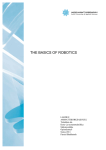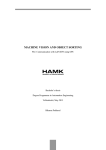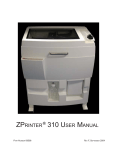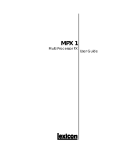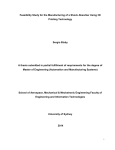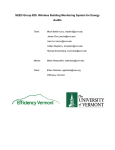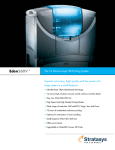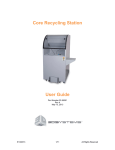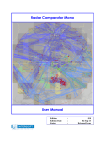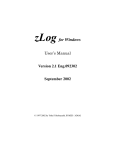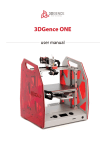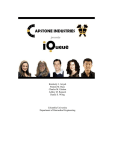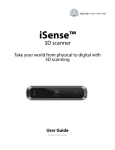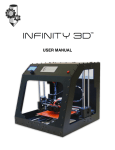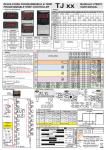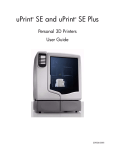Download Entry level 3D printers
Transcript
Entry level 3D printers Usage and Benchmarking Bachelor’s thesis Kone- ja tuotantotekniikka (Mechanical Engineering) Riihimäki, 2014 Petri Heino ABSTRACT HAMK Riihimäki Kone- ja tuotantotekniikka (Mechanical Engineering) Author Petri Heino Subject of Bachelor’s thesis Entry level 3D Printers Year 2014 ABSTRACT This thesis was made as a primer for getting more involved and specialized in 3D printing. The subject was proposed and the opportunity was provided by Aalto University's Digital Design Laboratory (ADD) located in the Otaniemi campus in Espoo city, in Finland. Ten different printers implementing four different 3D printing methods are introduced, with the machine prices ranging from 2000€ to 35000€. The writing is based on two months of intensive use and testing. The aim was to benchmark the printers and learn how to use them. A lot of new knowledge was acquired and the differences between a 2000€ printer and a 12000€ one became apparent. A well established base of knowledge was established for considerations of small-series manufacturing with the printers and their correct use and maintenance. Keywords 3D printers, FDM, FFF, SLA, SL, Stereolithography, Polyjet, inkjet. 3DP, powder printing, lamination Pages 61 p. TIIVISTELMÄ HAMK Riihimäki Kone- ja tuotantotekniikka (Mechanical Engineering) Tekijä Petri Heino Työn nimi Entry level 3D Printers Vuosi 2014 TIIVISTELMÄ Tämä päättötyö on tehty alustaksi erikoistumiselle 3D tulostimiin ja -menetelmiin. Aalto-yliopiston Digital Design Laboratory (ADD) ehdotti työn aihetta sekä tarjosi tilaisuuden ja mahdollisuuden tehdä työtä. Digital Design Laboratory sijaitsee Otaniemen kampuksella Espoossa. 10 erilaista tulostinta jotka käyttävät 4 erilaista 3D tulostus -menetelmää esitellään. Laitteiden hinnat ovat välillä 2000 – 35000€. Kirjoitus perustuu kahden kuukauden intensiiviseen käyttökokemukseen ja testaamiseen.Tavoitteena oli benchmarkata tulostimet ja oppia käyttämään niitä. Työssä kertyi paljon uutta tietoa ja erot 2000€ ja 35000€ laitteen välillä tulivat varsin selviksi. Työssä kehittyi hyvä tietopohja ja valmiuksia piensarjatuotantoa varten tulostimia käyttäen. Lisäksi tulostimien oikea käyttö ja huoltaminen nousivat selkeästi esiin työtä tehdessä. Avainsanat 3D tulostus, Stereolithografia, laminointi, pulveritulostus, pikavalmistus Sivut 61 s CONTENTS 1 INTRODUCTION......................................................................................................1 1.1 3D Printing nowadays.........................................................................................2 1.2 Terminology and technology...............................................................................3 1.2.1 Extrusion-based............................................................................................4 1.2.2 Photopolymerization-based..........................................................................5 1.2.3 Inkjetting-based............................................................................................6 1.2.4 Sheet lamination processes..........................................................................7 2 MATERIALS..............................................................................................................8 2.1 Wire filament materials.......................................................................................8 2.1.1 Build platforms for filament materials.......................................................14 2.2 Powder materials...............................................................................................15 2.3 Printable waxes.................................................................................................15 2.4 Liquid materials.................................................................................................15 3 THE PRINTERS......................................................................................................16 3.1 Extrusion-based printers....................................................................................17 3.1.1 Ultimaker 2.................................................................................................17 3.1.2 3D Touch....................................................................................................21 3.1.3 Gigabot.......................................................................................................22 3.1.4 UPrint SE Plus............................................................................................24 3.2 Stereolithography / Form 1+.............................................................................27 3.3 Inkjet printers....................................................................................................31 3.3.1 Objet 30 Scholar.........................................................................................31 3.3.2 Thermojet...................................................................................................35 3.3.3 ZPrinter 250 ..............................................................................................37 3.4 Sheet Lamination / Mcor Matrix 300................................................................39 4 BENCHMARKING THE PRINTERS.....................................................................42 4.1 Test prints..........................................................................................................43 4.1.1 Ultimaker 2.................................................................................................45 4.1.2 UPrint SE Plus............................................................................................51 4.1.3 Form 1 Plus................................................................................................53 4.1.4 Objet 30 Scholar.........................................................................................56 5 CONCLUSIONS......................................................................................................58 6 SOURCES................................................................................................................59 Appendix 1 Printer specifications Appendix 2 Test round-up Entry level 3D printers 1 INTRODUCTION 3D printing is a manufacturing technique that has also been called additive manufacturing and rapid prototyping. It is a method of manufacturing parts by adding material to build up a work piece incrementally, conversely to removing material from a blank as in machining. Making parts this way has several obvious advantages, such as saving material and reducing the need of patterns for molds. Aalto University's Digital Design Laboratory (ADD) offered a chance for learning how to use their machines and to get to know their capabilities. ADD laboratory had 10 different 3D printers available at the time of writing (2014). Besides believing that 3D printers will get much more popular in the future as a manufacturing method, motivations for starting this work were to gain knowledge how to coordinate a 3D printing shop/factory, would the printers be good for commercial small scale manufacturing, and what are the strengths, weaknesses and best applications for the printers available. Also learning how the different machines were constructed would provide a good chance to learn machine design perspectives. Before starting this thesis I had been interested in all kinds of additive manufacturing methods, but had only limited experience of using them, limited to RepRap building projects and using and improving a Minifactory 2 at my previous workplace. Therefore getting my hands on machines worth several thousand or tens of thousands of Euros was a unique and highly interesting opportunity for me. 1 Entry level 3D printers 1.1 3D Printing nowadays Extrusion-based desktop 3D-printer are getting widely popular, due to increasing visibility of the printers, but still industrial usage is dominant. These industrial machines are made by large and professional companies, from which the biggest two are Stratasys and 3D Systems. For the cheapest printers there are many big and small companies making them around the world. The onset of popularization of the extrusion-based 3D printers was mostly set by expiration of crucial patents and the very successful open-source RepRap project. Also, freely distributed designs and building instructions play a huge role with services such as Thingiverse (www.thingiverse.com) The open-source hardware and software on the internet is commonly distributed under either the GNU General Public License (GPL) or Creative Commons (CC)-licences. The CC-licences may have limitations to commercial use set by the publisher, the GNU GPL licence is a good example of a licence set to try to ensure the work to remain in public domain and not hidden under commercial use only. These licences have representatives in many countries and have even been successfully used in court. (GNU GPL, 2007, GPL Violations, n.d. See also Creative Commons Case Study, n.d.). Huge advancements have been made lately in the methods where a laser beam or an electron beam is used for joining powder metal together appropriately so that a work piece is formed, such as Selective Laser Sintering (SLS) or Direct Metal Laser Melting (DMLM) and are becoming competitors for traditional production methods with complicated designs especially in the aerospace industry. Recently in the 2014, General Electronics Aviation division established a 50 Million Dollar additive manufacturing facility in USA. (GE Press Release, 2014.) There is a wide range of different additive manufacturing technologies besides the ones mentioned in this thesis, but researching all of them is out of the scope of this thesis and the technologies will be reviewed only briefly. Interesting methods would be, for example, direct write methods including plasma ionization or deposition of powder metal through a nozzle that melts it at the same time with a laser beam. The reader is suggested to research them online, or to acquire for example, the book Additive Manufacturing Technologies, 2010, Gibson, I. Rosen, D. Stucker, B. E-ISBN: 978-1-4419-1120-9. 2 Entry level 3D printers 1.2 Terminology and technology Several different abbreviations are commonly used in 3D printer technology, some of which are reviewed here along with descriptions of the technology. (Gibson et al. 2010. See also Materialise, n.d.) As a general description, initially the part being manufactured is modelled in a CAD program, a 3D-model is made, and then this file is processed so that information for creating the part is made for the printer. 3D models are universally, somewhat standardized, transferred to the 3D printer software in a .stl format. In this format, the model is described in vertexes, triangles, that close the surface of the model. This format is supported by all the programs involved in this thesis and should be so in any programs involved in 3D printers. This .stl file is “sliced” into multiple layers, describing the toolpaths for the printers. The slicing generates standard g-code or a similar language, that is then sent to the printer's electronics, which control the different axis's and material deposition methods. The g-code is a standardized machine control language consisting of lines of commands, position coordinates, and settings for the machine to read and operate accordingly. 3 Entry level 3D printers 1.2.1 Extrusion-based FDM = Fused Deposition Modeling, a trademark by the Stratasys company. PJP, Plastic Jet Printing, a trademark by the 3D Systems company. May also be called FFF, Fused Filament Fabrication or just plainly extrusion-based systems. Figure 1 2010, 145). Schematic describing extrusion-based systems (Gibson et al. Molten thermoplastic material is liquefied and then forced through a nozzle, building up layers one after another. Usually thermoplastics don't have a certain melting point and therefore the usable temperature range can be high even for the same material. Higher temperatures may be necessary if printed at higher speed, but it is important to remember that plastics can thermally decompose if left at elevated temperature for long times. The material may be deposited either in filament form with a pinch wheel extrusion system or with a feed screw in granule form. The parts are usually built hollow with an infill pattern. 4 Entry level 3D printers 1.2.2 Photopolymerization-based In photopolymerization processes a thermoset plastic resin is used (thermoset means that the plastic is cross-linked and “rigid” after setting down and can not be thermally reformed as the polymer chains arranged so). The resin is delivered in liquid form and deposited differently in each method. All of the machines implementing this method subject to this thesis use ultraviolet light (UV, wavelengths ranging from approximately 300 to 400nm) to cure the resin. Resin also exist that are curable with light in the visible spectrum used in different printers. In Stereolithography (abbreviated SL, or SLA) the resin is in a tank and the part is built inside the tank, touching the liquid resin. Figure 2 Schematic of Stereolithography (Gibson et al. 2010, 65). The SL system may work opposite to the schematic in Figure 2, requiring less resin to be available, but having disadvantages such as forming adhesive forces between the tank and the build platform. In the Form 1 -printer, as an example, the build platform is lowered into the resin. The bottom of the tank is silicon coated plastic, and a laser beam, moved through mirrors inside the machine, is directed through the bottom of the tank. A scanning mask could be used instead of a scanning beam, as in some visible light -curing SL printers where a common household DLP-projector could be used (the LCD-screen blocking light the dark places). 5 Entry level 3D printers 1.2.3 Inkjetting-based The MJM (Multi-jet Modeling, an inkjet-printing method trademark by 3D Systems) and the PolyJet (inkjet-3D-printing method trademark by Stratasys) brand names are both photopolymerizing- as well as inkjetting-based methods. The polymer resin is jetted (pushed by piezo actuators) through small nozzles on to the build area. There may be multiple sets of nozzles in rows of many, as over 100 in the Objet printers, for the ability to deposit different materials. The resin may be heated up to reduce viscosity (make it flow more easily). A very thin layer of material is deposited with the inkjets and then a UV light is moved over the resin to cure it. The next layer is printed directly on top of the last one. 3DP is a method that implement powder and binder material to build parts. Note that the term may also relate generally to any 3D printing method. (Gibson et al. 2010, 195-200. See also Wikipedia 3DP, n.d.) The Zcorp machine uses a method of inkjetting a binder material (viscous fluid) in to a powder. The binder adheres adjacent powder particles together. A new layer of powder is deposited evenly with a spreader, that may be knife-like or a roller. Unused powder may be recycled and used to print again. Figure 3 Schematic of 3DP process. Note that with the photopolymer inkjet-printers, the part is built straight to the build platform and support material is also jetted and there is no powder used anywhere (Gibson et al. 2010, 196.) 6 Entry level 3D printers 1.2.4 Sheet lamination processes There are several different kinds of sheet lamination processes with different brand names associated with them. For example, the Mcor Matrix-printer uses a process named Selective Deposition Lamination (SDL) , where a titanium knife is used to cut a single layer of ordinary A4-paper that has been glued on top of a previously bonded and cut sheet of paper. The laminating processes are separated in two ways. The first way would be to first bond the laminated sheet and then form it. Conversely, the sheet can be first formed to the wanted shape and then bonded to the previous layer. Bonding means that a sheet is glued, thermally adhered, or, for example, ultrasonically bonded (called Ultrasonic Consolidation) to the previous one. Forming means that the sheet is cut to the desired shape with a knife, a laser beam, by milling it or by other methods. The bonded sheets may be almost any material, ranging from paper to ceramics to sheet metals. (Gibson et al. 2010, 207-210.) Figure 4 Schematic of one of the first commercialized lamination processes, the Layer Object Manufacturing (LOM) -process, (Gibson et al. 2010, 208.) 7 Entry level 3D printers 2 MATERIALS The used materials depend on the printing process as seen in the previous chapter. Notable about the materials is that the price can vary a lot. The used photopolymerizing resins have been getting considerably cheaper as the user-base is getting wider and with more printer manufacturers entering the market. This can also be seen on the wire filaments. The industrial-grade materials can be very close in chemistry to the ones used in the cheaper printers. However, the price difference can still be ten times. It is also good to remember that neither of the two stand up to comparison if compared to the price of thermoplastics used in the injection molding industry, where the material cost can be much lower, in the range of only a few Euros. 2.1 Wire filament materials The industrial grade spools come in sealed packages and include moisture absorbent material. The materials used in the uPrint machines are called ABS Plus with different brand names that are extruded at 300ºC according to the machine interface. The special spool holder type that they use, plus the included circuit board in the spools makes the use of custom filaments impossible or at least very difficult. The uPrint has fixed settings for extrusion temperatures. For lower price range printers there is a huge variety of different materials available. Currently there is no standard for the spool sizes and this causes problems with interchangeability between the machines. The spool format is manufacturer dependent. 8 Entry level 3D printers The specific chemistry and properties of each plastic type can differ greatly depending on the grade and the additives (such as plasticizers, colorants, fillers etc.). Very different properties have been experienced depending on the filament color for example. Figure 5 Filament spool fitted on the back of Ultimaker 2. 9 Entry level 3D printers ABS (copolymer of Acrylonitrile, Butadiene, and Styrene). Extruded usually at temperatures ranging from 220ºC to 260ºC. The uPrint machines use a grade of ABS that is extruded at 300ºC. ABS is subject to even violent heat shrinkages and warping during printing and therefore it is very demanding on the build platform. Printed parts can tolerate higher temperatures than PLA, as the glass transition temperatures for ABS are higher. For example MatWeb has over 2400 different grades of ABS listed on their website. There is no single universal form of ABS that you can get, but it's properties are somewhat manufacturer and grade dependent. (MatWeb ABS, n.d.) PLA (Polyactic Acid, Biopolymer). Extruded at 170ºC to 220ºC, however some grades may need a higher temperature of 245ºC to flow properly. Notable properties of PLA are as follows: • easier to print than ABS because of less warping due to lower extrusion temperature and it is less demanding on the build platform. Biodegradable material. Harder surface than ABS. Extruder usually need less force on the idler pulley because of the hardness of the plastic to avoid digging in to the filament. (MatWeb PLA, n.d.) • may degrade quite fast depending on the grade if the spool is opened from packaging and left unattended. The material becomes very hard and fragile and impossible to print. • may be used as support material for ABS. The supports can be removed by immersing the part in hot water for 48 hours or by using an ultrasonic washing tank with a solution of caustic soda for 3 hours. (3D Touch Ultrasonic support removal tank, n.d.) 10 Entry level 3D printers Wood filament. These filaments are mixtures of some ground wood material and PLA or some other plastic. Extruder blockages may be experienced with smaller nozzle sizes. Spools of wood filament were printed with extruder nozzle diameter 0,6mm without blockages or misfeeds. Material properties are similar to PLA, but the objects are much softer and weaker. Wood filament requires adjustments to the retraction settings on the printers to avoid getting leftovers between layer changes – it flows quite differently from PLA or ABS. With the wood filaments, changing extrusion temperature has a minor effect on the color of the resulting prints. Figure 6 3D-printed owl in wood filament, Thingiverse thing no. 18218. 11 Entry level 3D printers TPE (Thermoplastic Elastomer), Ninjaflex, Soft PLA. Extruded at 180ºC to 230ºC. Flexible, rubber-like materials of different varieties. Extruder has to be more rigid in construction for these filaments because the materials are very flexible. The extruder idler pressure also has to be adjusted correctly to be holding it under just the right pressure to avoid squashing the filament. Because of lower melting point and flexibility, printing settings have to be adjusted correctly. This has to be almost certainly done experimentally. When bridging (printing between perimeters, on top of nothing), a build area fan may prove necessary to reach acceptable details. (MatterHackers, n.d.) Experiments to print a red soft PLA material were made. A 150mm diameter ball, intended to be used as a corned guard, was printed with 5% and 10% honeycomb infill. The resultant balls were not as flexible as expected because of the honeycomb structure making it rigid on the edges. However, if printing only the perimeters (the outlines) of objects, much more flexible objects could be made. Figure 7 Ball printed in flexible PLA. 12 Entry level 3D printers PVA (Polyvinyl Alcohol). Water soluble. Extruded at 160ºC to 170ºC. Will absorb moisture once opened and may require drying before usage. Described to be used as a support material and supposedly will work best with PLA because it's extruded at lower temperatures – ABS is extruded at 260ºC and may cause degradation if printed on PVA. (Bilbycnc PVA Fact Sheet, n.d.) Nylon (Polyamide). Most Nylons are extruded at 240ºC to 250ºC. Nylon will most certainly require removing moisture before printing to avoid air or water bubbles. Flexible and durable material. Printing on blue tape or a wooden surface is recommended by the manufacturer. (Taulman 3D, n.d. See also Reprap Wiki Polyamide, n.d.) HIPS (High Intensity Polystyrene). The HIPS plastic is soluble in Limonene (an organic solvent), making it a possible support material for ABS. (RepRap Wiki HIPS, n.d.) 13 Entry level 3D printers 2.1.1 Build platforms for filament materials There are many methods to reach good adhesion to the surfaces but there is still room for improvement and the best ones are usually experimentally determined. Not all plastics can be printed on the same surface. Common problems are: first layer not adhering at all to the platform, parts getting detached from the platform during printing, parts warping under heat. Printing PLA on a clean surface of glass or aluminium might be possible after proper cleaning with dissolvant leaving no residues such as Isopropyl Alcohol. (RepRap Forums, n.d.) Table 1 Build platform types and properties, author's experiences. Platform Temperatu Successes material res Failures Other comments 3D LamiTouch nated plywood Room temperature PLA and TPE with coating of glue stick Double sided tape, ABS Weak mechanical construction leading to vibrations UltiHeated maker glass 2, plate Leapfrog Creatr Glass plate heated with a PCB board up to 100ºC PLA and Wood filament with plastic coating varnish spray (bed 75ºC), ABS with ABS Juice* (bed 100ºC) ABS warping with coating spray (bed 90ºC), thicker coating and higher bed temperature help The spray coating may be reused many times. Printing ABS needs glass plate preparations. Milled Room 5mm temperatuthick re aluminiu m plate Blue painters tape (3M) and Kapton tape successful with PLA and TPE. Originally too good adhesion worked out by setting z-axis offset +0,1mm No warping or detaching of parts experienced even with very large rafts Gigabot UPrint DispoSE sable Plus ABS plate Air heated to around 75ºC, visible on machine interface A raft of Reusing the Plates cost support plates may lead around 5€ a material is to parts getting piece. printed on detached from ABS plate, the plate then the actual part in ABS plastic on top of that *ABS Juice, a term coined on the RepRap forums and wiki for a mixture of ABS dissolved in Acetone and applied on glass plate. 14 Entry level 3D printers 2.2 Powder materials Many different powder materials can be printed, either by fusing or melting them together, or by using a binder material. The ZPrinter subject in this thesis uses a binder material to form objects in a special powder. The powder is, as suggested by it's Materials Safety Data Sheet, mostly water with color additives whereas the powder is a mixture of plaster and polymers (supposedly PVA or other water solvent polymer or glue). There have been records of people using alternative materials on their powder-binder-printers. For example, salt could be used. (RepRap Wiki Powder Printer Recipes, n.d.) 2.3 Printable waxes Waxes could be printed, such as those used in the Thermojet printer. The Thermojet uses waxes described as thermoplastics, made out of Hydrocarbons, Amides and Esters. The machine is discontinued but there are newer commercial casting-wax printers on the market. (3D Systems, 1998.) 2.4 Liquid materials The stereolithography (Form 1) and the inkjet printers (Objet) use UV curable resins. The resulting parts are of thermosetting plastic and very different in properties to the thermoplastics used in the extrusion-based printers. Little information about the chemistry of the resin can be found, mainly from the materials safety datasheets. Manufacturers give, however, technical properties for the plastics such as tensile- and impact strengths and glass transition temperatures. Traditionally, end users were limited to outsourcing the resins from the printer manufacturer. Nowadays there may be alternative options available for far cheaper prices, mainly because of the open source printers becoming more popular. (Makerjuice Labs, n.d.) The Objet printer uses a different support material deposited from a separate printing head during printing. The supports are removed by using pressurized water after printing. 15 Entry level 3D printers 3 THE PRINTERS The machines that were available for usage for this thesis are listed in tables two and three. More in depth analysis of the machines and user experience gained from this thesis can be found in the later chapters. Table 2 3D Printers Manuf-acturer Machine Model Cost (estimate) Extrusion Leapfrog Creatr, Creatr XL 1400€, 2012 4000€ (XL) Extrusion Ultimaker Ultimaker 2 2000€ 2012 Extrusion Bits From Bytes 3D Touch 2000€ 2010 Extrusion Re:3D Gigabot 2000€ 2012 Extrusion Stratasys UPrint Plus 15.000€ 2010 SL FormLabs Form 1 3300€ 2013 Inkjet/ MJM 3D Systems Thermojet 50.000€ (in the 1990s) Some time in 1990s Inkjet/ PolyJet Stratasys Objet 30 Scholar 35.000€ 2012 Inkjet /3DP Zcorp (currently owned by 3D Systems) Zprint 250 (currently Projet 260 by 3D Systems) 10.000€ 2010 SDL Mcor Technologies Matrix 300 11.000€ 2010 Table 3 Year made Materials processing equipment Machine manufacturer Machine Model Cost (estimate) Year made Stratasys WaveWash 2000€ 2012 (estimate) Stratasys WaterJet 2500€ 2012 (estimate) 16 Entry level 3D printers 3.1 Extrusion-based printers The most common printers nowadays are the cheap desktop FFF or FDM (called differently depending on the trademark and p) printers with prices ranging from 500 to 2000€. There are many companies manufacturing these printers and several different models were available for the thesis. Luckily also a more experienced one, the uPrint SE was also available and this provides a good comparison point for the cheaper ones. 3.1.1 Ultimaker 2 Figure 8 The Ultimaker 2 3D printer. The Ultimaker is a commercial spinoff from the RepRap project that has been getting popular throughout the world. It's based on the company's improved open source software and hardware, and all the files and plans at least for the older machines can be found online. 17 Entry level 3D printers For this thesis, three Ultimaker 2s were available for use. They proved to be constant in accuracy and reliable if serviced properly. Common problems in usage were: • Nozzles getting blocked when doing filament changes. The ABS or other residues block the extruder when printing PLA because of lower extrusion temperature. • Improper extruder idler tension, resulting in slippages when extruding. Problems may appear at the end of the spool. • Belts and bolts getting loose, requiring periodical attention and tightening. For belts, adding tensioners might be necessary. • Filament jams, the filament wire getting stuck in the spool holder or tangled in itself. • Filaments degraded at the end of the spools if old material (notable with PLA) • Difficult nozzle change procedures. Disassembling of the complete extruder assembly is required to change the nozzle. Besides these obvious problems faced with this kind of machine, the Ultimaker has proved to be able to produce good quality parts if serviced right and the used material was good as well. Some filaments are much easier to print than others. The Ultimakers would print without problems for tens of hours in a row. 18 Entry level 3D printers The Ultimaker has it's positive sides and it's negative sides. Printing simple geometries rather slowly would produce very satisfactory results reliably. Correct preparations would be necessary – if printing in ABS, the build plate would have to be prepared with ABS juice to avoid warping. Even with the ABS juice, some very large parts could still warp too much and become bent. Figure 9 Milling machine parts printed in ABS with the Ultimaker. The biggest piece was bent about 3 mm from the middle after removal. Heated bed at 100°C, with ABS-juice 19 Entry level 3D printers The printer has only one nozzle, but the Cura software is able to produce supports for the printed parts built with the same material as the actual part. Printing with supports works, but with too fine details removal becomes very work intensive and not worthwhile if done manually with sidecutters, a knife and a file. Usually every problem encountered with the prints came up with some change to the machine. If there was a change of spool, the new spool could get tangled. If the material type was changed problems with the nozzle were encountered. Therefore the Ultimaker might be best suitable for single-purpose use and not as a 3D printing testbench. Printing wood filament was tested on an Ultimaker. The prints constantly got blocked with the original 0,4mm nozzle. As a solution to this the nozzle had to be changed to a bigger one. A decision was made to drill the nozzle to a bigger size. This was done on a Bridgeport mill with a 0,6mm HSS drill. After one month of use, this same printer would suffer from material jam with the spool getting tangled and while servicing, the heater wire got broken because of too much bending. A new one would cost around 35€. Figure 10 The Ultimaker nozzle assembly showing the hot end and cold end with the cooler fan. Not showing the heater and temperature resistor in the brass block below. 20 Entry level 3D printers 3.1.2 3D Touch Figure 11 The 3D Touch printer The 3D Touch is a discontinued but still a rather popular printer in Finnish schools. It has it's own software tool path which is quite easy to use, but it doesn’t have many features for customization. The prints are very slow and the reasons are apparent. The printer is set to periodically ooze and clean the nozzle by purging it to a special container by wiping it against a plastic plate. The corner guard ball mentioned in chapter 2.1 took over 50 hours to print with the 3D Touch, compared to the Ultimaker 2, which took 13 hours on it. The build area is a sheet of laminated plywood. It can be challenging to find the best methods for proper adhesion to this surface. Printing ABS is practically impossible because of parts getting detached and warping. 21 Entry level 3D printers 3.1.3 Gigabot Figure 12 The Gigabot printer. Notice the missing extruder. The printer had suffered from extruder meltdown and molten plastic is visible on the build platform. The Gigabot was delivered as assembled from USA. It had been standing for long times without usage. It uses RepetierHost and common open-source components similar to the Leapfrog. The printer is poorly documented and no manual could be found. The settings for PC communication were iterated manually. Special about this printer is its promised large build volume of 600 x 600 x 600mm (compared to the usual 200 x 200 x 200mm of the other printers). However, printing big objects will take long times. An estimate of 180 hours was given by the software to print an almost full volume object with 0,3mm layers and 35mm/s speed with a 0,4mm nozzle. 22 Entry level 3D printers The Gigabot had many problems when taken into use. Firstly of all, prints were suddenly stopping after couple of layers. Secondly, the y-axle would skip 50 mm in a positive direction after 10 or so layers. These problems would appear randomly. The y-axle skipping resulted finally in a situation of apparent fire-threat. The thermistor from the extruder nozzle got separated from the heater block, possibly by getting stuck in the floating filament extruded in to air. This caused the heater to turn on maximum for almost 10 minutes, which melted the extruder barrel made of some temperature resistant thermoplastic. Luckily, the firmware aborted the print automatically after the said 10 minutes. Otherwise the situation could have resulted in the plastic catching fire. Now the only loss was the melted extrusion cold end that was plastic. The reasons for the skipping were investigated. Firstly, a too low belt tension was suspected, but apparently, the stepper motor drivers' currents were not adjusted by the manufacturer. This may have resulted in the motors skipping steps (losing positional accuracy). The motors would skip steps if loaded by hand when the printer was on. While investigating the printer for faults, it was clear that the stepper motor driver boards' current trim-pots had not been adjusted properly. They were all in the same orientation in the middle of adjustment range. 23 Entry level 3D printers 3.1.4 UPrint SE Plus Figure 13 uPrint SE Plus 3D Printer The uPrint SE Plus is an entry level industrial FDM printer. It has an air circulation system to heat up the enclosed build platform, disposable build plates and a purging and nozzle wipe system to keep the nozzles clean (the nozzle is wiped against a metal brush periodically). 24 Entry level 3D printers Compared to Ultimaker, for example, the uPrint has more electronics and sensors in use which detect, for example, material misfeeds and failures. This compared with the rigidity and it's custom-made parts make it a quite different kind of a printer than the Ultimaker. The printed supports make this printer a lot more versatile than the other FDM machines in this thesis. It is possible to print almost any shapes with enough supports, but this may be seen as a waste of the support materials, and printing both is time consuming. Figure 14 A complicated art-piece being printed with lots of supports to facilitate the printing of a shell structure. Total duration of this print was 40 hours, pictured in halfway The uPrint has got much better reliability and constancy than the other extrusion-based printers. Overall the printer requires less adjustments and tinkering with than the cheaper ones. The machine is constructed of high quality machined or fabricated metal parts. The supplied materials are expensive but of guaranteed high quality and packaged well. 25 Entry level 3D printers There are occasional errors especially in the material feed system. There can be material breakages in the extruder. In the worst case, the printer may print without either one of the materials because of breakage. This all requires attention from the user. The uPrint software, CatalysEX is rather limited in its customizability. Open source software such as Cura have many more options for manipulating the parts and changing print parameters such as supports and the part's wall thicknesses. This might seem negative at first, but it does eliminate the time-consuming experimentation quite effectively. This might be seen as positive or negative thing depending on the use. The software automatically generates support structures to be printed. The parts can be washed with the WaveWash system supplied by Stratasys to remove the supports. The washing system works by circulating tap water and an added mixture of Sodium Percarbonate and a mixture of Tetrasodium N, n-bis (carboxylatomethyl)-l-glutamate and Citric Acid added before starting the wash cycle. Mechanical removal is possible and in simple cases more effective. The filament spools are supplied by Stratasys. They are delivered in a sealed bags and there is moisture absorbent material inside the package. The spools include a small circuit board described as an EEPROM chip. This is, in effect, makes it very difficult if not impossible to use second hand materials on the printer. The spool prices can be as high as 190€ per spool if bought separately. The price can be slightly lower if the spools are bought in large amounts. The build plates cost around 5€ per piece. These are remarkably higher prices than with the materials used in the Ultimaker machines and the like, but of the same type of plastics. All-in-all, the uPrint is a reliable machine, but it's options are limited and it is very expensive to use when compared to the cheaper ones made by smaller companies. The combination of a well-maintained heated build platform and high quality plastics makes the print-results very consistent and good in mechanical properties. 26 Entry level 3D printers 3.2 Stereolithography / Form 1+ Figure 15 The Form 1+ stereolithography 3D printer The Form 1 works by lowering a metal plate build platform in the resin and using a 405nm wavelength UV laser that is directed by mirrors to polymerize a layer next to the previous one. The polymer tank comes pre-coated with a silicone gel to prevent the parts sticking to the tank. Tanks are disposable and are recommended to be used for 1 or 2 liters of printing. The Form 1+ version is a faster, later version than the Form 1 printer from Formlabs. (Formlabs Form1+, n.d.) There were two Form 1's for use for this thesis. The other Form 1 in use had a particular problem with printing from the start. The parts being printed would adhere too strongly to the resin tank and fail because of that. This problem would suffice despite changing the tank, the build platform, resin and fine tuning the zaxis. 27 Entry level 3D printers The other, a few months newer, would work much better producing constantly good prints with the cuboid. The difference between the two machines raised many questions, as if this would be a machine property, why would the same part print successfully on one but not on the other. Figure 16 An art piece printed with the Form 1. The printer works best with small surface area pieces, and doesn’t have problems producing fine details if they are properly supported. The pictured piece was broken during support removal, requiring gluing. Also sanding was needed for surface finish The Form 1 uses a notably user friendly PreForm software. It generates supports and estimates the successfulness of the prints automatically. The automatic support generation is a critical feature in this printer. Every trial made for this thesis to print without supports would fail. Also the part orientation plays a big role and reorienting may solve printing problems (but introduce precision problems, see later tests with the cuboids in this thesis). 28 Entry level 3D printers Figure 17 Form 1+ at 0,1mm layers on left, FDM printer at 0,1mm layers on right (Formlabs Layer height, n.d.) The Form 1's minimum feature size is defined as 0,3mm. It is capable of much finer details than the FDM machines. However, overhangs and intricate features present challenges and may result in failures. The printer needs to be maintained well and cleaned periodically. The resin tank especially has to be kept clean. Figure 18 n.d.) 27x magnification of the comparison (Formlabs Layer height, 29 Entry level 3D printers Notable about the build processes is that the scanning laser works very fast in the x and y-axes and print time depends mostly on the height of the objects (printing many similar sized ones does not increase time notably, whereas in the extrusionbased printers the time increases linearly with the volume). Unlike the extrusion-based machines, the pieces are printed solid as a default. To have hollow pieces, drain holes should be designed in to the piece. After printing, the parts are washed in Isopropyl Alcohol to remove uncured resin. The supports are mechanically removed by the user. Formlabs has provided very good documentation for all procedures on their website, including advanced tips for parts design, applications etc. Overall, the Form 1 is a good machine for fine details and small pieces. However, it has it's problems and correct use is a necessity. Keeping everything clean is time consuming, but with suitable pieces, the Form 1 is a very notable printer. The competing stereolithography 3D printers several times more expensive making the Form 1 a considerably choice at around 3500€ if it's features are needed. It is, however, not a clear winner over the extrusion-based printers as imagined by the writer before starting to use it. 30 Entry level 3D printers 3.3 Inkjet printers The inkjet 3D printers available are characterized as expensive and large in size. There are no cheaper printers available currently and the two available for the thesis were much more expensive ones than the other printers. The inkjet 3D printers work quite similar to the 2D inkjet printers as in material deposition, but the materials are of course different and there is an added z-axis and the inkheads also move in y-axis instead of moving the paper. 3.3.1 Objet 30 Scholar Figure 19 Objet 30 Scholar 3D printer pictured. The Objet printers work by depositing a very thin layer of resin on top of a previous layer and curing it with UV light. Layers are deposited next to each other to build up parts. There are two different nozzles, each one with over 100 small holes in a row for jetting the resin. The other nozzle is for the build material and the other for printing support materials. 31 Entry level 3D printers The Scholar is a 3D printer marketed specially for educational use but it is almost identical to the Objet 24 and Objet 30 Pro versions. The difference between different Objet machines is mostly in the availability of the materials. The resolutions are the same but the build area varies a little and the layer thickness is thinner in more expensive machines. Figure 20 Objet 30 materials availability. (AIPWorks Objet, n.d.) The machine for use had been standing for over a month without usage during the summer holidays. This had caused the nozzles to get blocked, most probably because of plastic polymerizing inside the nozzle - rendering them useless. Methods to open the nozzles were researched and burning them open in an oven at 400ºC seemed feasible. This has not yet been tried, because there are electronics, suspectedly piezo elements, embedded in the nozzle. New nozzles cost around 1000€ per piece, plus service fees. After the nozzle change, recalibration of the axes has to be made because of minor changes in the nozzle positions. One of the reasons adding up to the cause of blockage is clearly the price of materials. Flushing the nozzles spends much of the material and doing this has been avoided at all costs. 32 Entry level 3D printers Table 4 The Objet 30 Maintenance Schedule Program (Objet 30 Manual, n.d. 101). As described in the manual, the printer should not be turned off if in idle mode, but should be kept idling for up to one week. If the printer is not used for over one week, a shutdown wizard should be run on it – involving a flush/fill cycle. For shutdown, the nozzles should be first emptied, and then flushed with a cleaning fluid, sold separately. (Objet 30 Manual, n.d. 92-125.) If changing materials, flushing cycles are also necessary to have proper colors in the print if the color if changed. Changing to a darker color, the economy cycle will spend 65 grams (± 10%) with one cartridge. If changing to a clearer color, the recommended High-performance cycle will take 300 grams (± 10%) when replacing one cartridge. The washing cycle dumps the material in the waste collector. 300 grams of material costs around 100 to 150€. (Objet 30 Manual, n.d. 92-125.) 33 Entry level 3D printers Besides the materials used in this specific printer, Stratasys offers different materials, like the flexible Tango-materials. However, the usage of these is limited to the more expensive and advanced Objet Connex -family of printers. The prices for these may be over a hundred thousand Euros. The Objet 30 Scholar belongs to the Objet desktop -family. (Stratasys System Matrix, n.d.) The material resin prices are high compared to any other printer used. Prices per kilo range from 250€ to 350€. Support material costs 110€ per kilo. The materials containers have fixed last dates of usage and they have a RFID tag taped on their bottoms. The Objet is the most expensive machine to use of all the printers in this thesis. Not many pieces were printed with it besides ordered and paid work. The Objet can produce fine details and with supports, it should be able to print almost any shape desired. Testing these capabilities more deeply was, however, left outside this thesis. As seen in the Cuboid tests -chapter later on, the Objet seems to keep up to its promises as an accurate printer. Figure 21 The WaterJet washing station. Not pictured: pressure water pump (standard hardware-store type) and foot pedal for controlling the pressure. 34 Entry level 3D printers 3.3.2 Thermojet Figure 22 The Thermojet 3D printer. The Thermojet is a long discontinued inkjet printer made by 3D Systems several tens of years ago. The thermoplastic waxes used in the ThermoJet are particularly suited for creating patterns for investment castings. The melting temperatures of the thermoplastic waxes are 55 C for TJ2000 and 95 C for TJ88. The materials are fed in a solid-wax-form to the printer. Heaters are used to lower the viscosity of the wax and the machine has a 10 minute heat-up period before printing. Production of a similar material seems highly challenging. The materials safety datasheet in Finnish reveals little about the characteristics of the material, whereas the English datasheets tell even less. (3D Systems, 1998 & 2005.) The machine was taken into use. It had been standing in idle mode for unknown time. The test print cycle functioned. Connection to PC was made with a private LAN connection. 35 Entry level 3D printers 64 bit Windows 7 was used to communicate with the printer, with VirtualBox emulating Windows NT. After making the proper IP settings, the printer responded to ping-commands. For file sharing, a Windows private network sharing folder configurations needed to be made. After this it was discovered that the ThermoJet program crashed when trying to send a file to be printed. The most probable reason for this was some incompatibility error with the emulated Windows NT operating system. Because of time limitations, the software problems remained unsolved. The printer had been used several years ago for investment casting patterns successfully. 36 Entry level 3D printers 3.3.3 ZPrinter 250 Figure 23 The Zprinter Powder printer pictured. Notice the powder recycling station next to it. The ZPrinter 250 builds up parts by using a binder material to adhere powder particles together to form up parts in sequential layers. It uses cartridges from normal HP 2D-printers, HP11 and HP57. The HP57 cartridge is used to enable printing in 64 different colors in the ZPrinter 250. This is not available on the cheaper ZPrinter 150. 37 Entry level 3D printers The resulting parts are fragile and porous by nature and there are different methods that are recommended for infiltrating the part to reduce the porosity and increase the parts' strength. These include salt water spraying methods, Cyanoacrylate (super glue) treatments or using a specific ZBinder compound. Note that all links to the Zprinter 250 product page were redirected at the time of writing to the 3D Systems product page of their machine ProJet 260C. Zcorp, the original company, was bought by 3D Systems in 2012. (3D Systems press release, 2012) Solheim Additive Manufacturing Laboratory in the Mechanical Engineering Department on the University of Washington campus has been developing the binders and the powder materials on their ZCorp ZPrinter and these results are available online on their Open3DP-blog. They have been successfully printing objects in salt powder and other ground-up materials using custom binder-solutions. (Open3DP Blog, 2011a, 2011b) The ZPrinter 250 available for use had been unused for several months because of prints stopping after couple of layers and the machine giving error codes such as ”Slow axis pos err. Error 2303:0”. After reviewing the ZPrinter user and service manuals, it became apparent that the machine had not been serviced or cleaned according to instructions at this time. The service station especially was dirty and the axes hadn’t been lubricated as instructed. This was suspected as the source of the errors, but at a service visit from 3D System's Finland's representative, Multiprint Oy, a faulty idler pulley was discovered. A service component was ordered and the delivery took around 2 weeks. Because of the shortage in time, no test prints on the ZPrinter made it to this thesis. However, the prints should be accurate and gain some strength after infiltrating (means curing) with the ZBond- or a Cyanoacrylate-adhesive. 38 Entry level 3D printers 3.4 Sheet Lamination / Mcor Matrix 300 Figure 24 The Mcor Matrix 300 3D printer pictured. The Mcor Matrix works by gluing paper consequently on top of each other and cutting the desired geometry on it after gluing. The blade used is a titanium blade, scheduled for replacement after cutting 7000 meters. The price of the blades is running around 50 to 100 Euros. The adhesives cost about the same per litre. The Mcor must be left to idle to avoid blockages in glue delivery. The machine does a service routine of applying one layer of paper every 24 hours. Manuals recommend that it would never be shut down. It soon became apparent that servicing the machine is important. The blade may get stuck if the assembly is dirty. The glue delivery line might works badly if the deposition roller has any remains of adhered glue on it. 39 Entry level 3D printers Figure 25 Test piece tried with Mcor. Several trials were made to try to print the thin object in Figure 25 with 1mm features that were especially challenging to the Mcor. Printing the object with the extrusion-based machines or with the Form 1 printer presented practically no problems with it, the Mcor was constantly failing. Figure 26 Paper layers getting detached during printing. 40 Entry level 3D printers After proper maintenance of the glue deposition head and the blade, these similar problems were still present but lesser. Printouts have very different properties to the other printers. The layers are easily detachable and the parts are fragile but can hold up to compressive forces. Figure 27 A small gear of approximately 10mm in diameter, printed with the Mcor, showing easily separable layers. However, after the minor improvement in print quality after allaround cleaning and maintenance, every part tried on the printer would fail, even the semi-complex. If paper objects are a must, the printer should be investigated more, but with the obtained results the printer seems very limited in it's capabilities and very expensive to use overall. The machine is slowly consuming it's glue and blade when not in use, and both are expensive, raising questions about the future of this printer. 41 Entry level 3D printers 4 BENCHMARKING THE PRINTERS A test piece was used to contest the printers. The piece consisted of three cubes connected together in different planes. The cubes measured 16 x 16 x 16 mm each. The faces of the cubes were along the same planes. The diagonal of the squares connecting the cubes was 2mm and the fillets were 1mm. The cuboid was designed in Open Source CAD-program called FreeCad, version 0.14 and exported in .stl-file format. Figure 28 The cuboid visualized in FreeCad. It may be difficult to have an universal test piece for all the different printers. For example, the SL and inkjet printers, are able to print very small features, under 1mm, accurately, whereas FDM printers may struggle greatly. Different printers have their strengths and weaknesses. Zprint, Thermojet were both non-operational during the time of tests. Mcor was producing too inconsistent results and gave the impression of a very unreliable machine. None of these three could suggestively produce strong enough parts for purposeful handling of the pieces straight out of the printer. Therefore Zprint, Mcor and Thermojet were left out of the tests. These printers are most suitable for the specific parts designed for printing with them. The Ultimaker 2 stands out positively among the 2000€ price range printers. The other printers were not actively used for mechanical weaknesses or problems, or just because setting them up would be time consuming and would require a great amount of tinkering with to get them printing. Objet, Ultimaker, uPrint and Form 1 were selected for final tests. These were all in operation most of the time during the making of this thesis and proved to be the best printers in house. 42 Entry level 3D printers 4.1 Test prints During the preliminary tests on the printers, it became apparent that the cuboid should be printed in a 45 degree tilted position towards the build plate. This made the layer-wise properties of the print much better in the thin connection points. When the connecting ribs were printed parallel to the machine's build area's plane, they became noticeably weaker against bending in this direction because of layer properties. Also, it is obvious that this connection point is the weakest link and very low infill should not affect the overall material strength noticeably. The same behaviour has been observed in tensile tests performed on 3D printed pieces – strength of ABS test pieces printed in horizontal orientation could reach up to 80% of the tensile strength of injection moulded pieces, whereas parts printed in vertical orientation might reach only 25% of the strength before plastic deformation. Notable about the tensile tests is also that injection moulded ABS might deform (before breaking) up to 32%, while results for horizontal and vertical 3D prints are approximately 7,5% and 2,5% respectively. (Aula et al. Kon-41.4005 Loppuraportti, 2014, 21.) Printing in the 45-degree orientation had its positive and negative sides. FDM printers could knock the pieces down easily if the piece was not properly adhered to the build platform or warped due to heat distortions. After printing the cuboids, visual tests to notice distortions and differences and measurements with a Vernier's caliber were made. 43 Entry level 3D printers Figure 29 Bad surface finish as seen on the planes where supports were printed on preliminary tests on the Form 1. This is also the piece that is described as the “preliminary test piece” in the thesis. The surface quality of the parts is dependent on the orientation. If there is a support structure printed, the surface plane that the part is created on, after the supports, can have very rough finishes due to non-uniform material deposition plane. The deposited material doesn’t have a flat surface to be start with. This makes the later finishing operations necessary. With the Form 1, as the part is being peeled off the resin tank, there is some adhesive forces that may pull the piece out from the build platform, making the generated supports a necessity to keep the 45 degree angle oriented cuboid from falling down. 44 Entry level 3D printers 4.1.1 Ultimaker 2 Both 0,4mm and 0,6mm nozzles were used in these tests. It is hard to notice any difference between the two. With default orientation the connection point for the overhang would print stronger and a little bigger with 0,4mm nozzle, while the 0,4mm nozzle might have a little better surface finish than the bigger one, but this is hard to tell by visual inspection. None of the prints came out perfect from the printer but required finishing. The best results could be got with a small layer size and a 45-degree orientation with full 45-degree supports and probably a lower speed also. The used filament may also play an important role, as to not heat warp too much and to adhere well to the build platform because the surface area is low under the cubes. Several methods were tried with the Ultimaker, developing as more and more experiments were made. First tests were done with PLA filaments. There was White PLA, supplied by Ultimaker, and black PLA supplied by Weistek. The machine using the white filament used a 0,4mm nozzle and the black a redrilled 0,6mm nozzle. The machines were similar otherwise and purchased during the same time. Later on Natural ABS from Ultimaker would be used with the 0,4mm nozzle and a black spool of ABS from Bits from Bytes with the 0,6mm nozzle. 45 Entry level 3D printers Table 5 Ultimaker 2 test settings and approximations Printer Material Layer model size Print speed Infill Temperature Other notes Ultima PLA ker 2 and ABS 3mm spools 40 and 50 mm/s 20% Nozzle 210°C or 260°C, Bed 75°C or 100°C Several methods tried. 0,06 to 0,2 mm Print time (generated by software) Material cost 30min to 1h 30min per piece, depending on the settings. 1h 30min with layer size 0,1mm, 1,2mm solid layers on shells, 20% infill, print speed 50mm/s and generated supports 30€/kg (overall), 1,15 meters per cube, 9 grams (Cura estimate), so approximately 0,03€ or 3 cents. Figure 30 The cuboid oriented in 45 degrees angle in Cura. 46 Entry level 3D printers Notable about the PLA tests is that each one of the prints had some imperfections, less so with the slow but finer 0,06mm layer prints. Sanding and finishing with a knife or side cutters was necessary. If printed in default orientation, the overhang's lower surface had very poor surface finish with both grid- and line-type supports. Figure 31 in PLA. Cuboids printed at default orientation with grid type supports With the second series of tests, ABS filaments were used. The preliminary tests all failed for not being adhered properly due to warping on the build surface when it was treated with plastic coating spray. Therefore the ABS juice method was tried, which also failed when done with the Ultimaker Natural ABS -filament. This would get separated from the glass and form weak points with air bubbles between the film and the glass. 47 Entry level 3D printers Figure 32 ABS prints with Ultimaker Natural ABS getting detached when knocked over by the extruder nozzle due to heat distortions. Figure 33 Visual description of the thickness of ABS juice used. Acetone is fully evaporated in picture. A very runny solution was used, prepared with ABS Plus filament used in the uPrint SE Plus. Care must be taken not to break the glass by too fast cooling or heat-up. 48 Entry level 3D printers Table 6 PLA test prints results on Ultimaker 2. Build platform was sprayed with plastic coating spray and heated at 75°C. Extruder temperature was 210°C for each test. Each test was printed with both two printers one with white PLA and one with black. For each machine the toolpaths with correct nozzle diameters were generated using Cura 14.07. Test Pieces Cube no. at orienonce tation Layer size(s)* Support structures Results 1. 1 45 0,1mm, Touching degrees 0,25mm buildpla-te (T.b.), 60 deg*2, and brim With many different settings, the cube failed many times and the idea of printing single at once was abandoned. 2. 3 Default 0,2mm 3. 4 Default 0,06mm T.b. 60 deg. and Connection point between brim overhung cube much stronger than with 0,2mm layers. The printed pieces measured 15,9mm each. Connections 1,1mm on overhang and 1,4mm elsewhere. 4. 4 45 0,06mm T.b. 45 deg. and Best quality PLA prints degrees brim reached, measuring 16mm by sides and 1,3 to 1,5mm on connections. T.b. 60 deg. and The parts printed out brim completely, but the connecting point for the overhung square was unacceptably weak. Cubes measured 16 to 16,1mm. Connection points 1,1 (weak on both) to 1,9mm, strongest with nozzle 0,6mm between parallel ones. *Note that every print used 1,2mm for shell and bottom/top thicknesses, fill density 20% and 50mm/s for speed, except 40mm/s for the last tests with very low layer size. “Lines”-setting was used for generating supports. *2 The 60 degree support setting would generate support only for the flat surface between the two cubes on the sides whereas 45 degree generates in also on the sides of the cubes. See figure 25. Brim means printing a flat surface of one layer extending over the part to reach better surface adhesion. 49 Entry level 3D printers Table 7 ABS test prints results on Ultimaker 2. Build platform was treated with ABS+Acetone mixture and heated to 100°C. Extruder temperature was 260°C for each test. Each test was printed with both two printers one with white ABS and one with black. Test Pieces Cube at orienonce tation Layer Support Results size(s) structures* 1. 3 45 deg. 0,2mm T.b. 60 deg. and brim Printed without ABS juice – the outer cubes ended up bending and making a little round if compared to a flat surface. 2. 10 45 deg. 0,1mm T.b. 45 deg. and brim. White filament would distort from heat too much and fail easily, see figure 27. Black ABS would need machine fine tuning, see figure 29. Finished parts need post-processing after support removal, sanding etc. ABS Juice effective if made with suitable ABS. *See the table 5 for descriptions. Figure 34 A tray of 10 cuboids in ABS freshly removed from printer. Notice the amount of material oozing after layers suggesting either problems with the printer settings or the used material.. 50 Entry level 3D printers 4.1.2 UPrint SE Plus Printing with the uPrint was really straightforward and trouble free compared to the Ultimaker. The only problem faced was that when the part was oriented as seen in figure 35, the software would generate bad toolpaths and not print it correctly. Using auto-orientate resulted in successful results as seen in figure 36. The connection points have a strong feel to them. No further processing or experimentation was needed. Figure 35 Cuboid printed with uPrint SE Plus. Figure 36 Uprint test settings and approximations Printer Materi Layer size Print model al speed Infill Temperature Other notes Uprint ABS SE Plus Plus 0,254 mm Not selectable Sparse- low density 300ºC Support fill setting set to SMARToption Print time (generated by software) Material cost 1h 1min per one cube. 200€/kg (overall price, around 500cm3 per spool) Materials usage: Model Material: 6,9cm3, Support Material: 1,51cm3 adding up to approximately 4€ per piece. 51 Entry level 3D printers Figure 37 Cuboid printed with uPrint before support removal. The piece would easily break while removing if bent too much. Table 8 UPrint SE Plus print results. Machine / Visual Material and inspection supplier notes Uprint SE Plus / ABS Plus by Stratasys Caliber Finishing measurements min/max cube Layers easily 16 / 16,1mm. visible but Connections constant 1,5mm finish 52 Surface has smooth feel and no disturbing imperfections Finishing operations needed Support material easily removed with a knife Entry level 3D printers 4.1.3 Form 1 Plus The cube was printed with automatically generated supports. After the pieces were printed out, the part was washed in Isopropyl Alcohol and the supports were removed with sidecutters. Some sanding would be needed for a perfect finish. Imperfections were easily visible in the transparent resin. Figure 38 The cuboid oriented 45 degrees with automatically generated supports in PreForm software. Table 9 Form 1+ test settings and approximations. Printer Material model Layer Print size speed Infill Other notes Form 1 Clear Plus resin 0,1m Depends m, on layer 0,05m size m and 0,025 mm Solid / no option Trials to print with reduced supports led to failures with part falling off from the build platform. Print time (generated by software) Material cost 1h 34min with 0,1mm layers (actually 1h or less on the printer, also multiple pieces would print at just minor increase if printed simultanously) 125€/Liter (overall) Volume of one piece 18,5mL with supports Approximate cost 2,3€ per piece 53 Entry level 3D printers Figure 39 Picture of the skewness of the cubes printed with 0,1mm layer thickness. Part was oriented 45 degrees, suggesting either improperly tuned z-axis or some other fault. Table 10 Form 1+ print results. Machine / Layer Material size and supplier Visual inspection notes Form 1+ / 0,1mm Clear resin by FormLab s Squares badly 15,8 / 16,1mm. skewed up*, Connections 1,1mm. connection ribs very flexible and thin*, lots of imperfections and material voids*. Clear resin Caliber measurements Finishing min/max cube operations needed 0,05mm Some 15,9 / 16,3mm. improvement Connections 1,3mm. from 0,1mm layers. Suspected air bubbles or cured resin in tank making more imperfections. Washing the part in Isopropyl Alcohol to remove uncured resin. Support removal and sanding. Same as above. Clear 0,025m Best out of the 16,1 / 16,3mm. Same as above. resin m three. Connections 1,5mm. *The properties get better as layer size decreases and part becomes stronger/better quality/more rigid. 54 Entry level 3D printers All of the prints from the Form 1 included some visible imperfections and the reason for those is unknown. The resin tank was visibly clean and it had been on low usage. Other prints and preliminary tests with the Form 1 suggest that the machine is very accurate in the pure x-y axis motions. A preliminary test version was printed with default-orientation and it measured from 15,9mm to 16,1mm by the cubes' faces. Figure 40 Cuboid printed with Form 1 with 0,025mm layers. Notice the imperfections inside the cubes and the bottoms where the support structure was built. 55 Entry level 3D printers 4.1.4 Objet 30 Scholar Printing with Objet was easy, but expensive. When starting to print the cuboid, the build material resin bottles had expired by two days and the machine gave error codes for this and required material change before printing (wasting 1 bottle of unused resin worth 300€). The bottles have a RFID tag taped on to them that the printer reads the date from. The print was rather tall and that’s why it took a long time on the Objet. The Objet is fast if parts of the same height are built at once. Figure 41 Table 11 Printer model The finished cuboid after support removal printed on Objet. Objet 30 test settings and approximations. Material Layer size Infill Other notes Objet VeroWhite 900 DPI Full 30 (default, no (no Scholar options) options) Support material has no options and is generated automatically. Print time (generated by software) Material cost 4h 26min (1041 layers, multiple pieces would print at just minor increase in time if printed simultaneously) 300€/kg (overall model material), 150€/kg (overall support material), Consumption 27g model, 20g support, Approximately 11€ per piece. 56 Entry level 3D printers Figure 42 The same cuboid before support removal, covered in support material. The support material is fragile and sticky wax like substance. It is difficult to remove with a knife and best done on the WaterJet machine supplied by Stratasys. Table 12 Objet 30 Scholar print results. Machine / Material and supplier Visual inspection notes Caliber measurements min/max cube Objet 30 Scholar / VeroWhite by Stratasys Very 16,1 / 16,2mm. Connections Washing the constant, 1,6mm. support material milk-like off. texture with some surface roughness 57 Finishing operations needed Entry level 3D printers 5 CONCLUSIONS To start with, there were 10 different 3D printers to experiment with – 6 of them extrusion-based, 1 SL printer, 3 inkjets, and a sheet laminating one. In reflection, I spent most of my time experimenting with the 5 sub-10000€ extrusion-based printers, spending countless hours wanting to get something done on them that they would not produce with default settings. Besides the setbacks and unsatisfactory results with the cuboid tests, I would conclude that these kinds of printers can still be really capable printers, with experiences relating to using and building RepRap printers. It is only a question of what is demanded of them and how well you know your machine and materials. Possibly the Ultimaker could produce similar quality to the uPrint with the cuboids, but it may require more experimenting and possibly modifications to the printer. Also in the sub-10000€ range was the Form 1+. The test results were really disappointing because the printer was perceived as a high-precision printer. What was learned is that the more expensive printers are really worth consideration but also have their problems. Materials are expensive and modifications and repairs made by users are limited. Time usage is a big factor here – with industrial machines you spend less time on the machine but pay more – whereas on the cheaper printers you spend more time but pay sufficiently less. Finally by building your own printer and spending time to learn how everything works you end up using less time to do maintenance or changes. The selection of a suitable printer seems like a real personal and case dependent task. All-in-all, none of the printers that were reviewed gave completely satisfactory results. As for my own personal opinion and view on continuing this work, constructing my own printer seems like the best option cost and time-wise, either with a heavily modified RepRap, Ultimaker or similar extrusion-based printer. For anyone's particular solution, time, money and quality are the biggest questions. See attachment 2 for round-up of the tests. 58 Entry level 3D printers 6 SOURCES Additive Manufacturing Technologies, 2010, Gibson, I. Rosen, D. Stucker, B. E-ISBN: 978-1-4419-1120-9. E-book accessed through school network, also available as a paper version. GNU GPL, 2007, General Public License. Accessed 6.10.2014 http://www.gnu.org/copyleft/gpl.html GPL Violations, Vendor FAQ. Accessed 6.10.2014. http://gpl-violations.org/faq/vendor-faq.html Creative Commons Case Study, n.d. Technical Case Study. Accessed 6.10.2014. https://wiki.creativecommons.org/Special:SearchByProperty? title=Special:SearchByProperty&property=Tag&value=technical+details 3D Systems, 1998, Material Safety Data Sheet in Finnish. Accessed 6.10.2014. http://www.3dsystems.com/products/datafiles/thermojet/msds/MSDSTJ88_Finnish.pdf 3D Systems, 2005, Material Safety Data Sheet in English. Accessed 6.10.2014. http://www.3dsystems.com/products/datafiles/thermojet/msds/22647S12-00_SDS_TJ88_EU.pdf 3D Systems, 2001, Thermojet Datasheet. Accessed 6.10.2014. http://www.3dsystems.com/products/datafiles/thermojet/datasheets/TJ _Pr_DesignComm.pdf GE Press Release, 2014. GE Aviation Selects Auburn, AL for High Volume Additive Manufacturing Facility. Accessed 6.10.2014. http://www.geaviation.com/press/other/other_20140715.html Materialise, Technologies & Materials Overview, n.d. Accessed 6.10.2014. http://manufacturing.materialise.com/all-available-materials Wikipedia 3DP, n.d. Accessed 6.10.2014. http://en.wikipedia.org/wiki/Powder_bed_and_inkjet_head_3D_printing 59 Entry level 3D printers Stratasys Objet 30 data sheet, n.d. Accessed 6.10.2014. http://www.stratasys.com/~/media/Main/Secure/System_Spec_SheetsSS/PolyJet/objet30%20pro%20brochure_letter%20stratasys%20low %20res.pdf MatWeb ABS, n.d. ABS Property data page. Accessed 6.10.2014. http://www.matweb.com/reference/abspolymer.aspx MatWeb PLA, n.d. PLA Material overview. Accessed 6.10.2014. http://www.matweb.com/search/DataSheet.aspx? MatGUID=ab96a4c0655c4018a8785ac4031b9278 Ultimaker, n.d. Ultimaker 2 specifications. Accessed 8.10.2014. https://www.ultimaker.com/products/ultimaker-2 Taulman 3D, n.d. 618 Material specifications. Accessed 8.10.2014. http://taulman3d.com/618-features.html RepRap Forums, n.d. Forum discussion. Accessed 8.10.2014. http://forums.reprap.org/read.php?1,137841 Bilbycnc PVA Fact Sheet, n.d. Accessed 8.10.2014. http://www.bilbycnc.com.au/AboutPVABilbyCNCFactSheet.pdf Reprap wiki Polyamide, n.d. Accessed 8.10.2014. http://reprap.org/wiki/Polyamide RepRap Wiki HIPS, n.d. Accessed 1.11.2014. http://reprap.org/wiki/HIPS MatterHackers n.d. Webstore, Soft PLA description. Accessed 9.10.2014. https://www.matterhackers.com/store/3d-printer-filament/300mm-redsoft-pla-threequarter-kg Makerjuice Labs, n.d. Hobbyist resins. Accessed 9.10.2014. http://www.makerjuice.com/ Formlabs Form 1+, n.d. Form 1 tech specs. Accessed 9.10.2014. http://formlabs.com/en/products/form-1-plus/tech-specs/ Formlabs Layer height, n.d. Comparison of printers. Accessed 9.10.2014. http://formlabs.com/en/support/help/advanced/layer-heights/ Leapfrog, n.d. Creatr product page. Accessed 9.10.2014. http://www.lpfrg.com/creatr Cubify, n.d. 3D Touch data sheets, PDF. Accessed 8.10.2014. http://cubify.com/en/Products/LegacyDownloads Stratasys System Matrix, n.d. Available as PDF. Accessed 9.10.2014. http://www.stratasys.com/~/media/Main/Secure/Material%20Specs 60 Entry level 3D printers %20MS/PolyJet-Material-Specs/System_Matrix.pdf Mcor technologies, n.d. Matrix 300 plus product page. Accessed 9.10.2014. http://mcortechnologies.com/3d-printers/matrix-300-plus/ Stratasys uPrint SE, n.d. uPrint SE Plus product page. Accessed 9.10.2014. http://www.stratasys.com/3d-printers/idea-series/uprint-se-plus Open3DP Blog, 2011a. Salty parts blog post. Accessed 9.10.2014. http://open3dp.me.washington.edu/2011/03/salty-parts-3dp-in-salt/ AIPWorks Objet, n.d. Objet Materials (in Finnish). Accessed 22.10.2014. http://www.aipworks.fi/objet_materiaalit Open3DP Blog, 2011b. Salt printing Research report. Accessed 9.10.2014. http://open3dp.me.washington.edu/wpcontent/uploads/2011/03/Salt-Printing.pdf 3D Systems press release, 2012. Accessed 9.10.2014. http://www.3dsystems.com/press-releases/3d-systems-completes acquisition-z-corp-and-vidar ZPrinter 250 User Manual, n.d. Available for online viewing as a Scribd upload. Accessed 9.10.2014. https://www.scribd.com/doc/233066646/ZPrinter-150-and-250-UserManual RepRap Wiki Powder Printer Recipes, n.d. Accessed 10.10.2014 http://reprap.org/wiki/Powder_Printer_Recipes 3D Touch Ultrasonic support removal tank , n.d. User guide and safety manual . Available as a PDF-file. Accessed 10.10.2014. http://cubify.com/en/Products/DDDTouch Objet 30 Manual, n.d. Available as a PDF-file. Accessed 10.10.2014. http://www.ece.ubc.ca/~leos/pdf/tools/objet/manual.pdf Aula J, Qiongge T, Koskinen H, Isomaa T, Kinnunen A. Kon-41.4005 Loppuraportti, 2014, 21. 3D-tulostetun muovin materiaaliominaisuuksien määrittäminen. Aalto University, unpublished final report from a Mechanical Engineering course. 61 Title of thesis Appendix 1 Printer Specifications, in order of presentation. Ultimaker 2 (Ultimaker, n.d.) Speed: 10 - 300 mm/s (user definable, default 50mm/s) Layer thickness: 0,02mm to 0,25 mm (user definable, nozzle size limits the maximum, default 0,1mm) Build volume: 230 x 225 x 205 mm Files transferred via an SD-card. Maximum nozzle temperature: 260ºC Maximum heated bed temperature reached: 100ºC Build platform type: Heated glass plate Used filament: any thermoplastic of diameter 2,85 – 3 mm (not able to print 1,75mm filament because of molten plastic reaching and blocking the cold-end of the nozzle, tested) • Settings are completely customizable in the Cura software by the user, making it quite versatile machine for experienced users. Other softwares could also be used for slicing, such as Slic3r. Besides this, the generated gcode can be customized manually. There are many materials available. PLA and ABS are the most common materials. Bits From Bytes 3D Touch (Cubify, n.d.) Speed: maximum 15 mm/s Layer thickness: 0,125mm Build volume: 185 x 275 x 210 mm (triple extruder) Files transferred via an USB memory stick. Maximum nozzle temperature: 260ºC Build platform type: Laminated plywood Used filament: any thermoplastic of diameter 2,85 – 3 mm Re:3D Gigabot Speed: 10 - 300 mm/s (user definable) Layer thickness: 0,02 – 0,40 mm (user definable) Build volume: 600 x 600 x 600 mm Files transferred via an microSD-card or USB cable. Build platform type: Aluminium plate Used filament: any thermoplastic of diameter 2,85 – 3 mm Title of thesis Leapfrog Creatr and Creatr XL (Leapfrog, n.d.) Speed: 10 – 60 mm/s (user definable) Layer thickness: 0,05 – 0,35 mm (user definable) Build volume: 230 x 270 x 200 mm (z-height 500mm on XL) Has to be constantly connected to computer via USB Maximum nozzle temperature: 260ºC Maximum heated bed temperature reached: 100ºC Build platform type: Heated glass plate Used filament: any thermoplastic of diameter 1,75 mm Stratasys uPrint SE Plus (Stratasys uPrint SE, n.d.) Speed: undefined, similar to default Ultimaker Layer thickness: 0,254 mm or 0,330 mm Build volume: 203 x 203 x 152 mm Files transferred via Ethernet (Windows 7 only). Build platform type: Heated build area by circulated hot air, disposable injection molded ABS plastic tray. Used filament: Diameter 1,75mm ABSplus in 9 colors (only 1 color in the basic uPrint model) and support material, SR-30XL. • Set timers for parts replacements and maintenance, like the nozzles, which are changed every 2000 hours or the 500h maintenance routine to keep things in good condition. • Interface displays the temperatures the time of printing as: Build material extruder 300 C, Support material extruder 300 C and build chamber 75C. Formlabs Form 1+ Speed:, fast in x-y Layer thickness: 0,025mm, 0,050mm or 0,100mm Build volume: 125 x 125 x 165 mm Files transferred via USB connection to from a PC. • Preform -software has very good user interface, but lacks machine settings, such as laser beam power and speed settings that you might be interested in if you use custom resins. Objet 30 Scholar. (Stratasys Objet 30 data sheet, n.d.) Speed: fast in x-y Build Resolution (from Objet30 Pro datasheet): X-axis: 600 dpi, Y-axis: 600 dpi, Z-axis: 900 dpi Size: 82.5 x 62 x 59 cm Weight: 93 kg Build Size: 294 x 192 x 148.6 mm Layer Thickness: Horizontal build layers down to 0.016mm Connection by Ethernet (includes embedded computer) • Seen on the printer software, the print area is kept at ambient temperature of 31°C and the print heads are kept at around 73°C to 76°C during printing. Title of thesis 3D Systems ThermoJet (3D Systems, 2001.) Build materials: ThermoJet 2000 and ThermoJet 88 Thermoplastic Wax build material Resolution 300 x 400 x 600 DPI (xyz) Maximum model size 250 x 190 x 200 mm Machine dimensions W1.37 x D0.76 x H1.12 m Machine weight 375kg Connection by Ethernet Zcorp ZPrinter 250 (ZPrinter 250 User Manual, n.d. 2-3.) Build speed: 2-4 layers per minute Build material: zp 150 Powder with zb 63 Binder Build Size: 185 x 236 x 132 mm Machine dimensions: 74 cm wide x 79 cm deep x 140 cm high Machine weight: 166 kg Resolution: 0,102mm, minimum feature size 0,41mm Connection by Ethernet Mcor Matrix 300 (Mcor technologies, n.d.) Build material: standard A4 Paper Build Size: A4 Paper: 256 x 169 x 150 mm Resolution theoretically 0,1mm (paper thickness) Machine dimensions 950 x 700 x 800mm Machine weight ~150kg Connection by Ethernet Title of thesis Appendix 2 Test round-up





































































